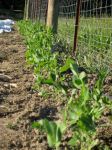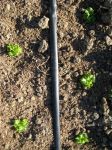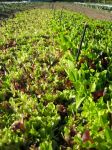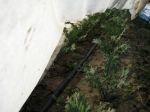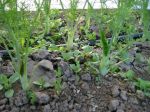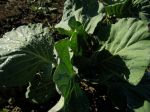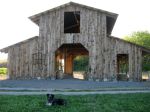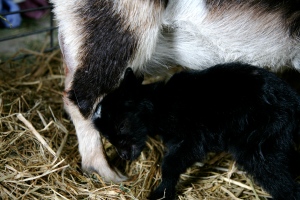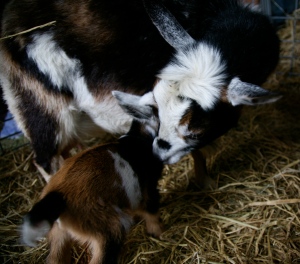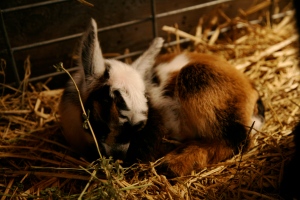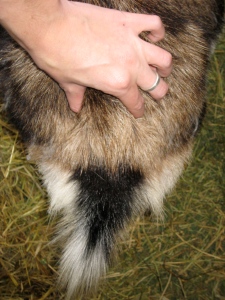About a week ago I snapped some photos of the little plants that are sneakily growing into big plants in rows and fields around the farm. If you’re in the mood for a scavenger hunt, you can sift through the photos and see if you can identify the various vegetables in their teenage phases. Below you’ll find: cabbage; broccoli; beets; kohlrabi; fennel; baby salad greens; head lettuce; peas; tomatoes; eggplant; garlic; onions.
Category Archives: Farm Beauty
A Birth Story!
After a week’s worth of partially sleepless nights — waking at midnight, 2 a.m., and 5 a.m. to check on pregnant Emily — we pulled an all-nighter. There’s nothing like staying awake all night with a laboring goat to make you feel like a true farmer — especially if you trade off with other farmers to steal catnaps on hay bales, wrapped in a sleeping bag, shivering in a half-awake delirium and listening intently to every noise and breath sound the goat makes.
Starting at about 10 o’clock on Friday night, Emily began to show classic impending labor signs. She started pawing the ground, trying to make a nest. Amber-colored goo — amniotic fluid — began streaming out of her vagina. Emily is normally a sedate, quiet goat, but she became very affectionate and vocal, talking to us and to her stomach, and crying loudly when we left the barn. She flehmened — which is a sexual response found in sheep and goats where they curl back their lips to better smell pheromones. She sniffed the ground. She yawned. She couldn’t get comfortable, standing, lying down, and constantly readjusting herself. She chewed on her back, hoofs, and stomach, as though everything in the world was irritating her. She licked her stomach like a cat. She seemed to experience occasional mild contractions, her back arching ever so slightly and her tailhead raising.
But she still wasn’t pushing, and she wasn’t in what goat owners call “heavy labor.” Until 5:41 a.m., when quite suddenly she got serious. Inbetween contractions (which were happening every minute or two) she stood up. But when the contractions hit, she lay down, stretched out her legs, stiffened her body, and heaved. Her breathing was also really heavy, almost to the point of grunting.
I was in the kidding stall with her, bracing her legs and watching her vagina for progress–she was opening up a bit, but no sign of a bubble or kid yet. I called to Emmett, fast asleep on the hay bales. He continued to be fast asleep, no matter how loudly I said the word “Emmett.”
After a few pushes I climbed out of the kidding stall and tapped him. He was very confused by the whole situation, having been deep in dreams, but leapt out of his sleeping bag and came over to watch. I climbed back in the pen, and could see she was making progress — so I asked Emmett to get Susannah and Austin, our wwoofers who were going to assist with the birth. No sooner had they arrived (also a little groggy and confused), when a bubble appeared… first pulsing in and out with the pushes, then out to stay. Emily screamed a couple of times, the labor at its most intense. And then, just a couple of pushes after the bubble stayed out, a baby jettisoned out into my hands, butt-first.
I immediately started to pull off the mucus and clear off his face with the towel, but he wasn’t moving. He was limp, and sort of stretchy feeling. We used the aspirator — that little plastic snot-sucking bulb — to clear out his mouth (grey, lifeless tongue hanging out the side) and nostrils. I kept rubbing him vigorously, just in case, but Emmett grabbed the stethoscope and confirmed that he had no heartbeat. We continued trying to resuscitate him for a bit but it was pretty clear he was already long gone by the time he made his entrance in the world.
After so much waiting, our hearts were broken… Would there be any more kids? Was that it? I reached around Emily’s belly, about to “bounce” her to see if there were any more babies inside. But no sooner had I done so when, barely two minutes after the birth of the first one, Susannah shouted, “The next one’s coming!” Her words were somewhat of a premonition. (It wasn’t “the other one,” just the next one.)
The next one came out kicking to try and break out of the thick red sac enveloping it. We were thrilled to see signs of life, and immediately set about trying to get the baby cleaned off. We grabbed the aspirator again and cleared out the baby’s mouth and nostrils. That was literally all we had time to do before Susannah announced the birth of the next kid. We were shocked — she had three in there?! Austin took care of getting the second kid rubbed down, cleaned and dried off, and showed him to Emily so she could help with the process. (Emily, sadly, was trying her hardest to wake up the stillborn, who was on a towel on the floor of the kidding stall — so Emmett moved him away.) Then Emmett, Susannah and I set to work clearing the third baby’s lungs, and getting her cleaned off. She had a bit more mucus in her mouth than the first and was coughing and sneezing, so I gently but firmly held her by her back legs and swung her upside down to drain all of the fluid out of her longs.
At this point, I should mention why getting the kids cleaned off is so important, and so much of a challenge. The thing is, babies don’t come out like babies. They come out like a package wrapped in red plastic wrap, inside which is an ocean of water and goo, beneath which is a tiny scrawny creature that is trying desperately to breathe and doesn’t quite look ready for the world. It’s amazing that, within half an hour, these fetus-things turn into real goat babies… fluffy, trying for their first steps, and suckling with a bit of human help on mama’s teat.
Emily passed her afterbirth and immediately began chowing down on the large bloody organ-looking thing. (This seemed to be the one job more important than licking the babies — and licking babies is a job she’s been taking very seriously ever since they were born 36 hours ago.) We snipped & dipped the kids’ umbilical cords (in iodine), got them started nursing, and lifted their tails to check their genders: 1 boy and 1 girl. The boy is named “Emilio” since he is a debonair, gregarious mini-Emily. His coat patterns look just like mom. Middy, aka Midnight Oil for our long night of midwifing, is a fine-boned black doeling with a white cap and possibly a couple of moonspots. She was a bit weaker at first and took longer to find the teat on her own, but with a bit of patience (and goat Nutridrench) she’s now capering all around the kidding pen.
But that’s not the end of the story. Once we were sufficiently recovered to have the chance to look more closely at the stillborn, we realized that the stillborn kid was HUGE. Like nearly twice the size of the other kids. And overdeveloped — he had a full set of teeth, and his (ahem) “male parts” were unusually large. I remembered something very odd that Emily’s previous owner had mentioned to me; she’d taken Emily in for an ultrasound to confirm her pregnancy before selling her, and the vet had said that the fetuses weren’t the same size, so he didn’t think the fetuses were the same age. In other words, Emily had become pregnant but cycled again, and was impregnated a second time since she was in a pen with a buck. The vet also had written on the ultrasound sheet that Emily had “1+” babies inside her, which I had assumed meant that he confirmed sighting of one baby and thought that there may be others — but in retrospect I think meant that probably 1 would make it, and there may be another underdeveloped one that wouldn’t.
So while we’re sad for the big brother who never made it, we’re grateful that super-mom Emily kept all three babies in her belly until the two littler ones were ready for the world. Because right now, snuggled together under a heat lamp in the barn, are a handsome buckling who is the spitting image of his mom and a beautiful black doeling: siblings who are already the best of friends. Given Emily’s capacious udder and great mothering & birthing ability — to be able to birth a breach baby unassisted is impressive, to be able to birth an oversized lifeless breach baby in time to get the other kids out alive is pretty amazing — we’re thinking of keeping Emilio as a possible herd sire. (In other words, letting him keep his male parts intact so he can eventually make more babies.)
The stillborn is buried up under the alpaca tree, just behind the barn, where our guardian alpacas sleep and where he’ll be close to his family. Emily, Emilio, and Middy are happy as can be, snuggling and nursing, sleeping and cavorting, trying to jump up on top of mom and competing for the best teat (which is apparently the right one, much to the chagrin of Emily’s overfull left udder). And we human farmers are grateful that we can finally get a good night’s sleep — at least until April, when 3 more goats are due!
Filed under Farm Beauty, Farm News, Farm Tales
The Waiting Game
Did you ever play the Waiting Game as a kid? It was one of those games generally forced upon children by short-tempered parents, like the Quiet Game or the Use Your Restaurant Voice Game, and in the same class as the Clean Plate Club (a club which typically required your membership only when your plate sported broccoli or spinach). In other words, not very fun.
Unfortunately, it turns out the Waiting Game isn’t just for kids. It’s also for goat owners awaiting kids.
We moved expecting mama Emily into a comfy, plush kidding stall inside the barn on Friday morning, thinking she was due on Valentine’s Day (Sunday). We pulled out all the stops for our mother-to-be: put down soft, fresh straw for her to lie on, rigged up a pen out of hog panels (perfect for goat back-scratching), gave her her own personal alfalfa feeder, grass hay feeder, mineral feeder, water bucket. We threw open the windows and doors when it was sunny to let in light and fresh air and shut them as soon as it cooled down to keep the barn as warm as possible. I checked on her constantly, waking in the middle of the night and trudging to the barn to check on her, to try and make sure that we’d be there to help her out no matter what time the kids decided to arrive.
Well, it’s Tuesday, I haven’t slept more than a few hours straight in 5 nights, and Emily has shown exactly zero signs of imminent labor.
Her ligaments (the ones that run from her pinbones to her tailhead and disappear before labor) seem to soften and then firm up and then soften again, teasing me.* Her udder is continuing to fill slowly, but isn’t anywhere near full, and hasn’t shown the sudden 24-hour ballooning that typically precedes labor. Her teats seem to be starting to swell… but then again, no. Her hips seem a bit hollowed out, her belly seems to be sitting lower (indicating the kids are moving into place to make their entry into the world)… but then again, maybe that’s just wishful thinking. She has a very tiny bit of mucus discharge but nothing like the large amounts that indicate the loss of the mucus plug and the onset of labor.
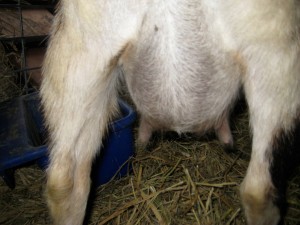
Emily's udder is filling up, but isn't yet tight and shiny. Her teats aren't filled with colostrum, either.
In other words, we have no idea when she’s going to kid! We bought her bred from Brandywine Farms (a wonderful family farm in the foothills of the Sierra), but the breeding date wasn’t known precisely, and when Emily was ultrasounded, the vet wasn’t exactly sure how far along she was. They gave a window of 15 days, the first possible due date being Valentine’s day.
So for now, back to the waiting game. And hoping that Emily will let me get some sleep before March!
——-
*FYI, signs that a goat is close to labor are:
- Loss of ligaments — specifically the ligaments along the back end of her spine, past the pin bones but before the tailhead — to the point where you can almost reach around the spine.
- “Hollowing out” of hips and a “mushy” hind end as babies drop into place and all other muscles relax to let the birth canal open up and the uterus get to work.
- Udder is tight and shiny, filled with fresh colostrum.
- Teats are swollen, taut, and full of colostrum, ready for babies to suckle.
- Mucus discharge… aka “string of goo” from the goat’s vulva.
- Goat may start to talk to babies (arching head backwards and nickering to stomach). Goat may paw the ground to try and make a nest for kidding.
- Some more subtle signs are “going posty,” which is when the doe starts to walk sort of funny and the back legs look stiff and post-like. Also, the tail will arch in a funny way.
- And of course, the biggest signs that a goat is going into labor are… contractions! And then, of course, the appearance of two little hooves, and the kid.
Filed under Farm Beauty, Farm Tales, Farming Info, Uncategorized
catching up is hard to do
Yesterday, for the first time in weeks, I didn’t post anything — not even a picture. Shame, shame.
To make up for it, I’m going to post a ton of pictures today, and try to teach you a thing or two about my arch-nemesis plant: the tomato.
I’ll explain why it’s my arch-nemesis in a sec, but in the meantime, I’ll give you a quick photographic recap of the time Emmett and I spent on the east coast visiting pasture-raised dairies and small-scale organic farms. Part of the reason I’ve been struggling to find time to post is the massive amount of catch-up we’ve had to do upon returning from our vacation. (That, plus the chicks who are growing rapidly but still ridiculously helpless, plus other work.) So it seems fitting that I catch up on the blog, too, and get a few of these pictures up! Here goes.
In upstate New York, around Hamilton — home to Colgate University, which actually does link to the toothpaste via trustee — local food is easy to find. Driving along a rural road, you might happen upon a cheese shop tucked right next door to the milking parlor and approximately 100 yards away from the cows that produce the cheese. (Yes, it really is this picturesque. Note the wind power being generated in the background.)
Or you might happen upon another cheese shop that’s home to New York’s largest reservoir of fine aged cheeses. You can buy 14-year-old cheddar here, no joke:
Jewett’s also has unbelievably delicious cocoa-coated-almonds (not like anything you’ve ever tasted — dusty, bitter, silky, sweet, in that order), and an excellent selection of local jams, honeys, and dry goods. And, of course, cheese — if you’re a sucker for flavored cheese like I am (think: dill, garlic, sun-dried tomato) or fresh cheese curd that squeaks when you bite into it, this store is the place for you.
But back to the cows. The photo at the top of this post is proof that dairy workers rise at O Dark Thirty (my family’s way of saying Way Too Early) every morning. The sky was still dark, but the cows were in the milking parlor, the lights were on, and the guys were milking! ‘Course, the pictures are better in the daylight — here, the cows are coming out of the milking parlor, udders drained, to find their way down the dirt lane to the pasture:
And finally, a contrast for you. This dairy used to be a conventional, confined operation. In the first photo, my arms are opened to the amount of space that each cow would live in — in the cement floor, you can still see the sockets where posts previously divided the stalls. (You can see why I’m looking a bit melancholy in this photo. A cow would live in this space her entire life, 24/7 — eat there, poop there, sleep there, and be milked there. She’d be fed at the end in front of me, and her poop would drain down the gutter behind me.)
The last three photos depict Emmett’s cousin’s cows, free-ranging in beautiful upstate New York.
I’ll put the tomato story in a new post, so that people looking to learn about tomatoes won’t have to scroll through my make-up pictures first! Over ‘n out.
Filed under Farm Beauty
the dance of the beans
From the moment they rear their little heads — seed noggin, leaf-ears — out of our crusty clay soil, I fall in love with beans. The way, even as youngsters, that they politely tuck their leaves down at night and raise them to greet the day each morning. The patterns that emerge from twining so irregularly around whatever happens to be in their path, leaving loud cursive loops leading up to the runner’s final serif.
Sure, there’s something a bit dark about them — clambering up each other, grabbing desperately for light, using other things to support themselves rather than developing a strong enough stem on their own. But if it’s dark it’s also beautiful: the evolutionary efficiency, the speed of growth, the brilliance of the bean’s little dance that leads it to twine around objects. It’s a marvelous adaptation. (Have you ever seen a strangler fig? Gorgeously sinister.)
Next year, perhaps, we need to plant them further apart… there are sometimes five or six stalks to a single piece of fence wire, and I have a feeling it’s going to be tough trying to locate beans in the midst of this forest, come harvest-time. It’s practically a full-time job trying to hook errant runners onto the fencing, too.
Still, I enjoy the dance.
Filed under Farm Beauty, Farm Philosophy


